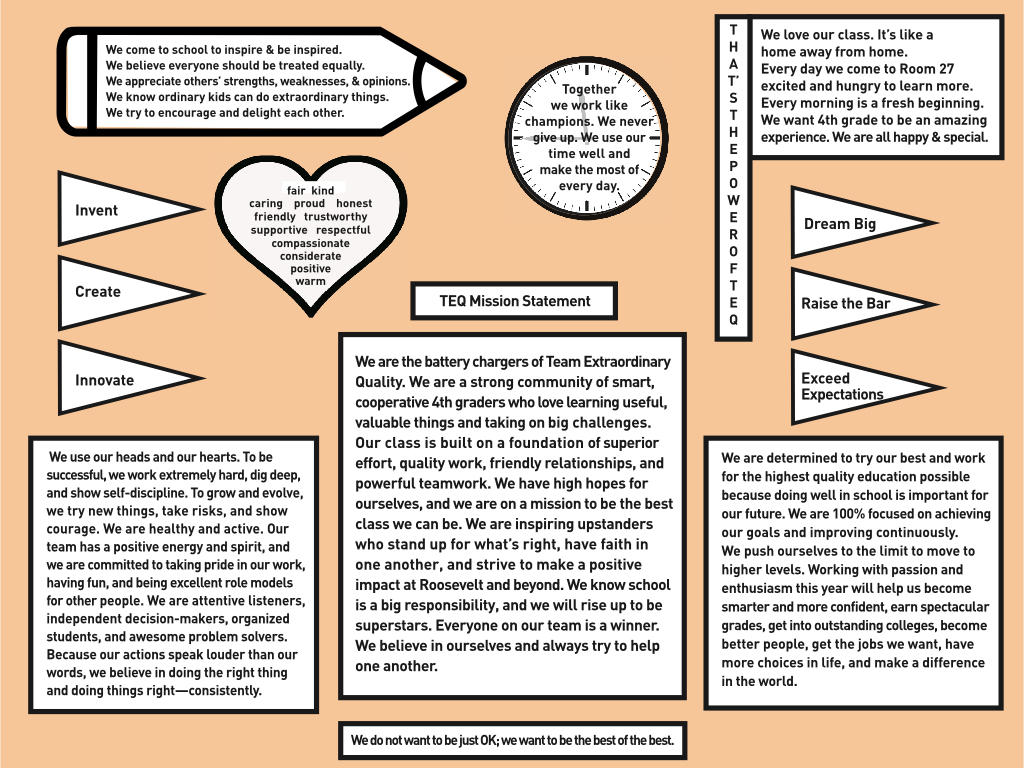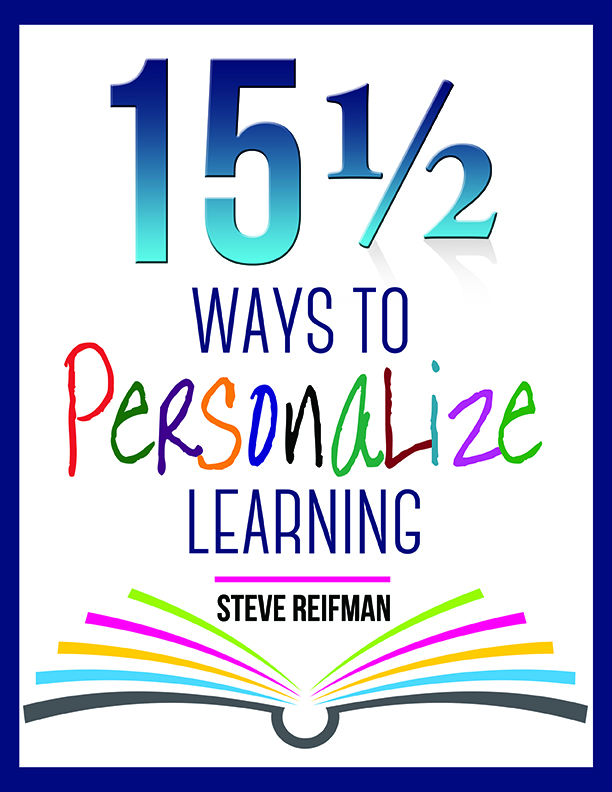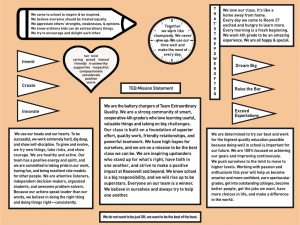Displaying items by tag: classroom management tips
A New Look for This Year's Class Mission Statement
 My students and I just completed our class mission statement, and I decided to try a different format this year. Rather than present our ideas as a series of paragraphs, I designed the document to look like the front wall of a classroom. The text was fit inside a whiteboard, two bulletin boards, a clock, a flag, and other "classroom-themed" shapes. As much as possible, the meaning of the text matched the object in which it was placed. For example, the words "we use our time well and make the most of every day" were put in the clock. My hope is that this novel format will resonate with my students and give our ideas greater meaning.
My students and I just completed our class mission statement, and I decided to try a different format this year. Rather than present our ideas as a series of paragraphs, I designed the document to look like the front wall of a classroom. The text was fit inside a whiteboard, two bulletin boards, a clock, a flag, and other "classroom-themed" shapes. As much as possible, the meaning of the text matched the object in which it was placed. For example, the words "we use our time well and make the most of every day" were put in the clock. My hope is that this novel format will resonate with my students and give our ideas greater meaning.
Click here to see the full-sized version of our new class mission statement.
Exciting Video Announcement
 In this video I announce the release of my new e-book on amazon, 15 1/2 Ways to Personalize Learning. In the book I present a variety of proven, user-friendly teaching strategies, ideas, and activities that simplify the challenge of personalizing student learning and enable educators to meet children’s diverse needs confidently, effectively, and joyfully.
In this video I announce the release of my new e-book on amazon, 15 1/2 Ways to Personalize Learning. In the book I present a variety of proven, user-friendly teaching strategies, ideas, and activities that simplify the challenge of personalizing student learning and enable educators to meet children’s diverse needs confidently, effectively, and joyfully.
This teaching resource is divided into four sections.
Part 1: Personalize the approach students take to their work
Part 2: Personalize academic instruction (This part includes my favorite method of integrating technology in the classroom.)
Part 3: Personalize student goals
Part 4: Personalize each child’s classroom experience
There is also a link in the book that provides access to a free PDF with over 25 printable pages that make it easy to incorporate the book’s ideas in the classroom.
Click here to see the book on amazon.com.
Click here to see the video.
Accomplish More During Your Parent-Teacher Conferences (Teaching Tip #124)
To minimize the time I needed to spend on the former and maximize the time I could spend on the latter, I decided to make a short video, and I asked each family to watch it before they arrived at their conference. The video contains the general information that I would normally mention during each meeting. By having everyone watch the video prior to the conference, I was able to jump right into the information that pertained to each specific child and keep the focus there for the duration of the meeting. I found the conferences to be more efficient and effective than the ones I've conducted in the past. An added bonus is that I didn't have to repeat the same information 29 times since I already provided it in the video. Click here to watch.
A Simple Way to Give Students More Personal Attention (Teaching Tip #123)
This past week my students and I found a new way to make the week even more special for the Student Leader. It all started when I picked the stick of a child we will call Tracy, who wears a flower in her hair each day to school. Before I excused the class for recess, I jokingly said that everybody's homework over the weekend was to find a flower and wear it in their hair on Monday as a tribute to Tracy's student leadership.
Sure enough, the following Monday, five kids arrived at school with flowers in their hair. When Tracy saw this, she was absolutely beaming. I made a big deal out of this during our morning circle, and even more kids started wearing flowers in their hair for the rest of the week. Our class mission statement includes a sentence that says we want to go beyond the expectations of a typical 4th grade classroom. I explained that if we could find a way to honor our Student Leader each week, we could make that person feel extra special, and it would definitely be a way for us to surpass typical expectations.
Yesterday, I chose a stick, and as a class, we brainstormed ways we could honor the young man who had just been chosen. We came up with ideas such as wearing blue shirts (because he said he liked wearing blue shirts) and doing something to acknowledge his love of reading and volleyball. It will be interesting what the kids come up with. I'm hoping to keep this idea alive throughout the year because it has such potential to strengthen our teamwork and give everyone the type of individual attention that makes us feel unique and special.
Help Students Improve Their Reading Comprehension, Part 3 (Teaching Tip #122)
This visual focuses on the skill of predicting and includes three main teaching tips.
1) Readers can use their knowledge of the characters to predict what will happen next.
2) Readers can use their knowledge of story structure to predict what will happen next.
3) Occasionally, readers need to revise their predictions as they read.
In case you missed the first two visuals, you can click on the following links to access visuals focusing on the strategies of envisioning and inferring. I hope you and your students enjoy these tools and find them useful.
Click here for a jpeg copy of the predicting visual.
Help Students Improve Their Reading Comprehension, Part 2 (Teaching Tip #121)
Student understanding of inferring increases even more when they perform the following chant while referring to the visual. This chant, along with several others, can be found in my book Rock It! Transform Classroom Learning with Movement, Songs, and Stories.
This "call and response" chant begins when children say the words "story clue," put their palms together, and then open the hands as if opening a book. Next, they make the addition sign with their forearms as they say, "plus." In part 3, they point to the brain and say, "my own knowledge." After that, they say "equals" and make the equal sign with their forearms. Finally, they say "inference" and make a capital "I" with their hands: one hand vertical, the other hand going back and forth to make the top and bottom horizontal lines. Doing this chant a few times per day over a period of days leads to excellent results.
Click here for a jpeg copy of this visual.
Help Students Improve Their Reading Comprehension, Part 1 (Teaching Tip #120)
This week I am sharing with you the visual that brings to life our first strategy, envisioning. For children to understand what they read, they need to be able to see "the movie in their mind" clearly. As teachers, we want to encourage children to picture the story so well that they actually feel like a character in the book.
Using Roald Dahl's Charlie and the Chocolate Factory as an example, this visual provides a nice introduction to these concepts. The popcorn image located at the top right further reinforces the idea of "watching a movie" as we read. Visuals #2 and #3 are coming soon.
Click here for a jpeg copy of this visual.
Try This Active Learning Strategy with Your Students (Teaching Tip #119)
This year's approach features a few significant changes. First, instead of having my students copy the sentences, I type the sentences and distribute a sheet to each child. We use transparent "sleeves" that envelop the whiteboards so that when the kids make the corrections with the markers, the actual sheets inside the sleeves stay clean, and I can re-use the sheets in future years. Because the kids are only making the corrections instead of copying entire sentences, we can proceed through each sentence much faster and accomplish more word work in less time.
Second, instead of working alone, every child now has a partner, and the pairs begin each sentence in a standing position. Before the kids sit down to make the corrections together, they "move through" the sentence by acting out specific movements that correspond to the types of changes they need to make. For example, as they read the sentence aloud, the kids spin in a circle every time they encounter a misspelled word. When we correct misspellings on the paper, we circle the word and write the correct version above the circle. So, the spinning corresponds to the circling they do on the paper. At the conclusion of this post, you will find some other examples of the movements we make for different types of corrections. Please e-mail me via this site if you'd like to know moves we make for other types of corrections, or, better yet, simply create your own with your students.
Once the kids have moved through the sentence, they sit down and make the corrections with the markers. After a couple minutes, we go over the answers together as a class. Incorporating movement has added tremendous energy and engagement to our word work, and the kids are paying greater attention to detail than they did under our more sedentary approach. In addition, working with partners allows the kids to help one another more easily and provides an important sense of belonging. In short, the kids are learning more, bonding more, and displaying greater enthusiasm with this active approach. As I mentioned in my book Rock It: Transform Classroom Learning with Movement, Songs, and Stories, movement has the potential to turn potentially dry academic lessons into engaging, multi-modal experiences that kids will remember for a long time. If you use other active learning approaches in your classroom, please contact me. I'd love to share them.
• To show that we need to indent, we do a skier jump from left to right.
• To change a lower case letter to a capital, we duck down to the ground and then rise up and extend our arms (as if doing the wave).
• To change a capital letter to lower case, we start with our arms extended above our heads and duck down to the ground.
• To insert a comma, we hop on one foot.
• To insert a period, we jump on two feet.
FREE Teaching Visual to Help Your Students Understand the Benefits of Exercise on the Brain
This week I am happy to share with you a helpful visual that connects to both of these goals. Exercise powerfully impacts focus, memory, and overall cognitive functioning. In addition, research has shown that exercise actually grows new brain cells. One well-known author has even referred to exercise as "miracle grow for the brain." As teachers, we want children to know and understand the benefits that exercise offers.
In future posts I will share specific ways that we can build more movement into the school day to take advantage of these incredible benefits. I invite you to contact me if you would like to share any effective active learning strategies that you use in your classroom.
Click here if you'd like a copy of this visual.
FREE Teaching Visual to Help Your Students Produce Higher Quality Work
I refer to this image as the "Tug-of-War" visual because it is common for children to have two goals in mind while they are working, and these goals sometimes conflict. First, they want to do a great job. Second, they want to get done.
Throughout the year, I emphasize to my students that quality is always the most important priority, and we need to be willing to take our time, focus on the task at hand, and put forth our very best effort if we wish to be successful in school and in life.
I have discussed this "tug-of-war" concept with my class for a couple years, and the idea of two little people wrestling in their minds resonates with children. I'm excited to have this visual to aid student understanding of the points I'm trying to convey, and I hope you find it useful.
If you'd like a copy of the visual, please e-mail me via this website. Just let me know whether you prefer a PDF or a jpeg. Thanks.






